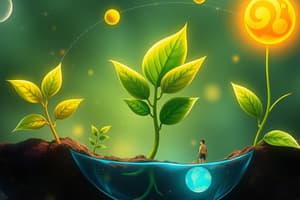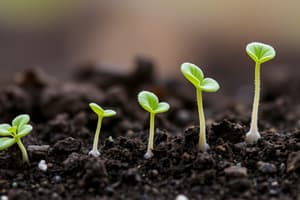Podcast
Questions and Answers
What are the three key elements required for seed germination?
What are the three key elements required for seed germination?
- Nutrients, oxygen, and sunlight
- Carbon dioxide, sunlight, and water
- Sunlight, water, and soil
- Water, oxygen, and warmth (correct)
The seed coat protects the seed from sunlight exposure.
The seed coat protects the seed from sunlight exposure.
False (B)
What is the primary function of the roots that emerge during germination?
What is the primary function of the roots that emerge during germination?
Anchoring the plant and absorbing water and mineral salts
Tiny openings on the leaves, called __________, take in carbon dioxide from the air.
Tiny openings on the leaves, called __________, take in carbon dioxide from the air.
Match the following plant parts with their functions:
Match the following plant parts with their functions:
What is the purpose of seed leaves in the early stages of plant growth?
What is the purpose of seed leaves in the early stages of plant growth?
Photosynthesis involves taking in oxygen and releasing carbon dioxide.
Photosynthesis involves taking in oxygen and releasing carbon dioxide.
How do plants reproduce in the absence of flowers, using an example?
How do plants reproduce in the absence of flowers, using an example?
__________ is necessary for flowers to develop into fruits.
__________ is necessary for flowers to develop into fruits.
Match the following terms with their roles in plant reproduction:
Match the following terms with their roles in plant reproduction:
What happens to the seed leaves after the first true leaves appear?
What happens to the seed leaves after the first true leaves appear?
Fruits are always dispersed by animals eating them.
Fruits are always dispersed by animals eating them.
What is the function of stomata in leaves?
What is the function of stomata in leaves?
During germination, __________ grow downwards, anchoring the plant.
During germination, __________ grow downwards, anchoring the plant.
Match the following stages with their descriptions:
Match the following stages with their descriptions:
What role do insects play in the life cycle of a flowering plant?
What role do insects play in the life cycle of a flowering plant?
The primary function of fruits is to attract insects for pollination.
The primary function of fruits is to attract insects for pollination.
What is the purpose of a plant's flat and wide leaves?
What is the purpose of a plant's flat and wide leaves?
__________ uses sunlight, carbon dioxide, and water to create food for the plant.
__________ uses sunlight, carbon dioxide, and water to create food for the plant.
Match each dispersal method with its description:
Match each dispersal method with its description:
Flashcards
Seed Coat
Seed Coat
Protective outer layer of a seed that shields it from insects and infections.
Germination
Germination
Process where a seed wakes up and begins to develop into a plant.
Germination Requirements
Germination Requirements
Water, oxygen, and warmth are the crucial elements required for a seed to germinate.
Seed Leaves (Cotyledons)
Seed Leaves (Cotyledons)
Signup and view all the flashcards
Root Development
Root Development
Signup and view all the flashcards
Stomata
Stomata
Signup and view all the flashcards
Photosynthesis
Photosynthesis
Signup and view all the flashcards
Pollination
Pollination
Signup and view all the flashcards
Fruit Development
Fruit Development
Signup and view all the flashcards
Seed Dispersal
Seed Dispersal
Signup and view all the flashcards
Study Notes
- The video explains the life cycle of a flowering plant, from seed to adult, narrated by a tree.
Seed Stage
- The life cycle begins with a seed, which has a seed coat for protection against insects and infections.
- Germination is when the seed wakes up and development begins.
- Germination requires three key elements: water, oxygen, and warmth (WOW).
- The seed contains stored food within its "seed leaves" to provide energy for initial growth.
Germination and Root Development
- During germination, the roots are the first to emerge from the seed.
- Roots grow downwards, anchoring the plant and absorbing water and mineral salts.
Leaf Development and Photosynthesis
- The first true leaves appear after the roots have developed.
- As the plant grows taller, the seed leaves wither and fall off as their food supply is used up.
- The plant begins to produce its own food through photosynthesis.
- Leaves have flat, wide surfaces to trap sunlight.
- Stomata, tiny openings on the leaves, take in carbon dioxide from the air.
- Photosynthesis uses sunlight, carbon dioxide, and water to create food for the plant.
Reproduction
- The plant matures into an adult and produces flowers, signaling its readiness to reproduce.
- Some plants, like ferns, reproduce using spores instead of flowers.
- Pollination and fertilization are necessary for flowers to develop into fruits.
- Pollination can occur through insects (like bees) or wind.
Fruit and Seed Dispersal
- After pollination and fertilization, some flowers turn into fruits.
- Fruits contain seeds, which are the starting point of a new plant life cycle.
- Fruits are dispersed through various means, such as falling to the ground or being eaten by animals.
- Seed dispersal allows seeds to germinate in new locations, restarting the life cycle.
Studying That Suits You
Use AI to generate personalized quizzes and flashcards to suit your learning preferences.




